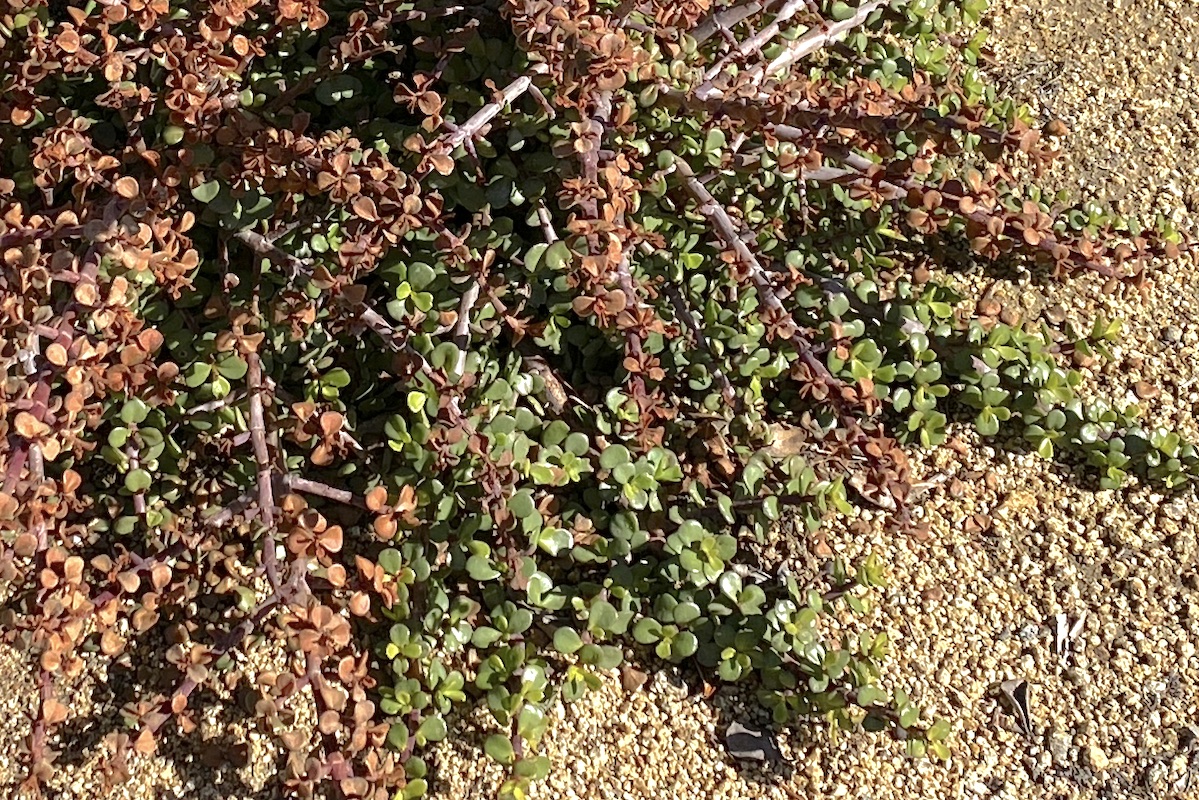
Oh No, My Succulents Froze!
It depends. Here's how frost-tender succulents looked before temps dropped into the mid-20s F, and after:
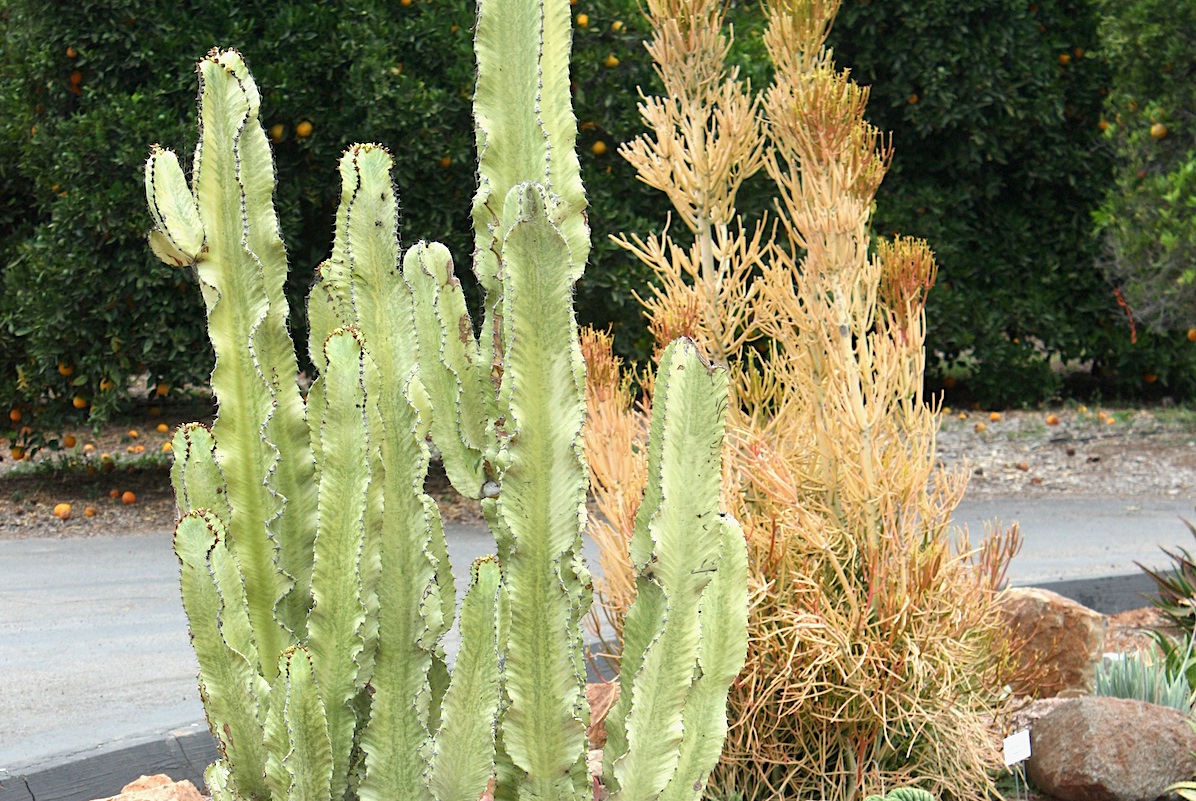
Euphorbias before frost
Here’s the same Euphorbia ammak ‘Variegata, after the frost:
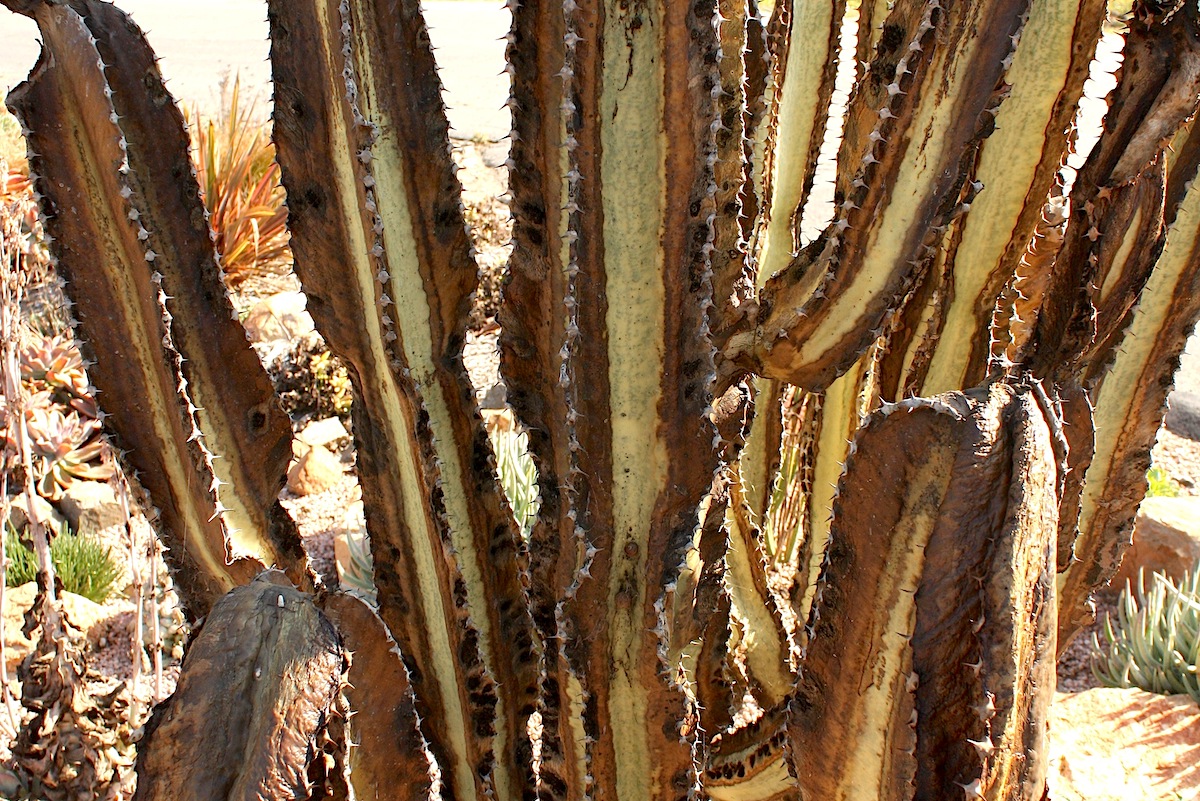
Euphorbia ammak after frost
Likelihood of recovery: Nil. Too much of the tissue was damaged.
But what about the Euphorbia tirucalli ‘Sticks on Fire’ behind it? It’s hope of recovery is excellent because only the top growth froze. It protected the stems underneath, which are still healthy.
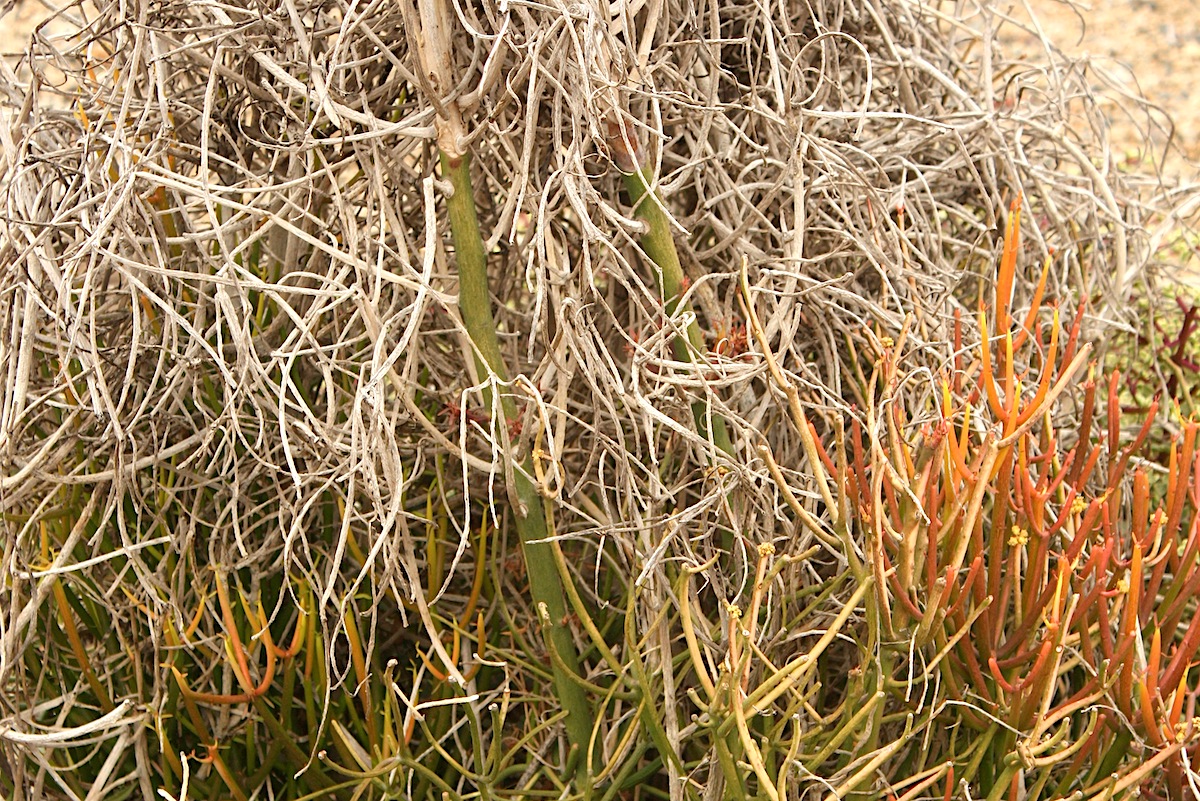
Euphorbia tirucalli 'Sticks on Fire' after frost
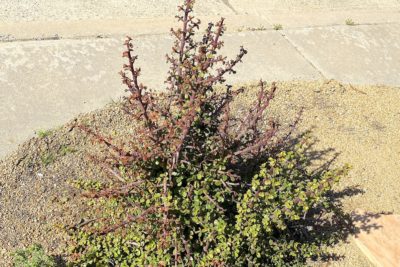
This frost-burned Portulacaria afra (elephant's food) will be fine. The top growth froze, but it shouldn't be pruned until all danger of frost has passed. It serves to protect the healthy plant underneath.
If something similar has happened to your plants, succulent or otherwise, once all danger of frost has passed, prune the dead top growth and the plant will be good as new…except smaller, of course!
How about the frozen aeonium below? Pretty much hopeless. But look a the Sedum ‘Angelina’ surrounding it. It’s a succulent too, and perfectly fine!
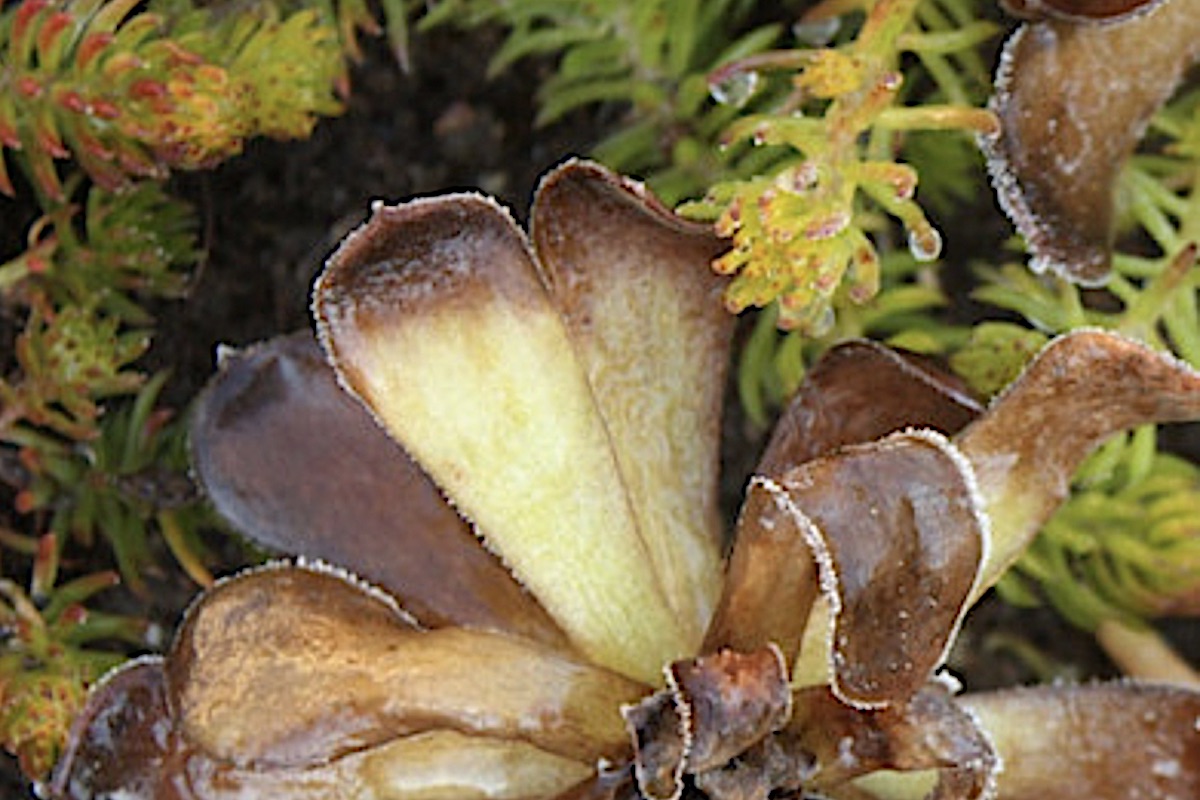
Sedum angelina with frozen aeonium
Why does frost kill some succulents and not others? A lot has to do with where a particular kind of plant originated. Succulents, which store water in their leaves to survive drought, are mostly from dry, hot climates. But some are from dry, cold climates. See my Wall Street Journal article on this topic.
If Your Succulents DO Become Damaged
Remove collapsed leaves if it's likely they'll rot, because that threatens the health of the plant. If instead they dry out, they'll help protect healthy tissue from future frosts. Leave them on, then prune after the weather warms.
Preserve the symmetry of slender-leaved succulents (such as agaves and aloes) by trimming tip-burned leaves to a point, rather than cutting straight across.
Chalk it up to experience. Now you know that particular plant is vulnerable and needs a protected location.
How to trim a frost-burned Agave attenuata
The tips of the leaves of this common succulent melt at 32 degrees, but the plant will survive. Here's how to make it look good again---only takes a minute!
https://www.instagram.com/p/BgUbYMFnhRM/?taken-by=debralbaldwin
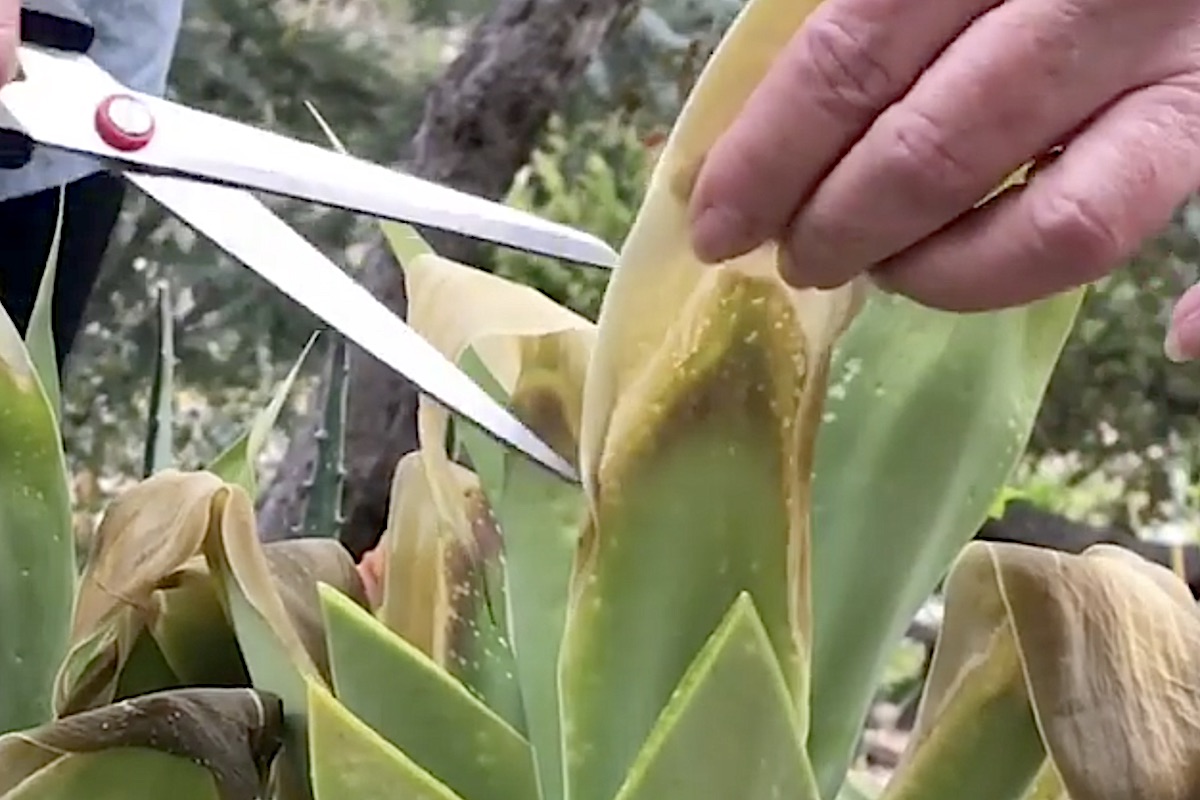
I trim Agave attenuata leaves by cutting their tips to a point, below frost-damaged tissue
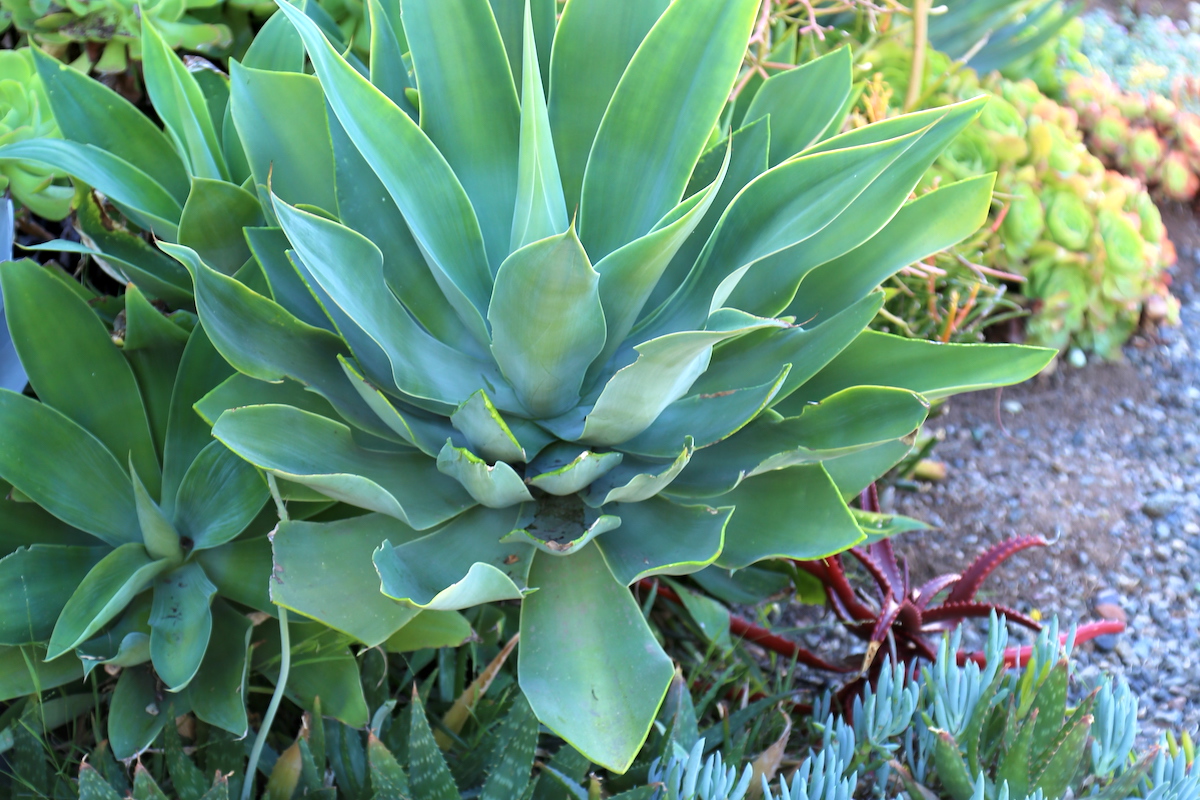
Above: Frost-damaged agave after pruning.
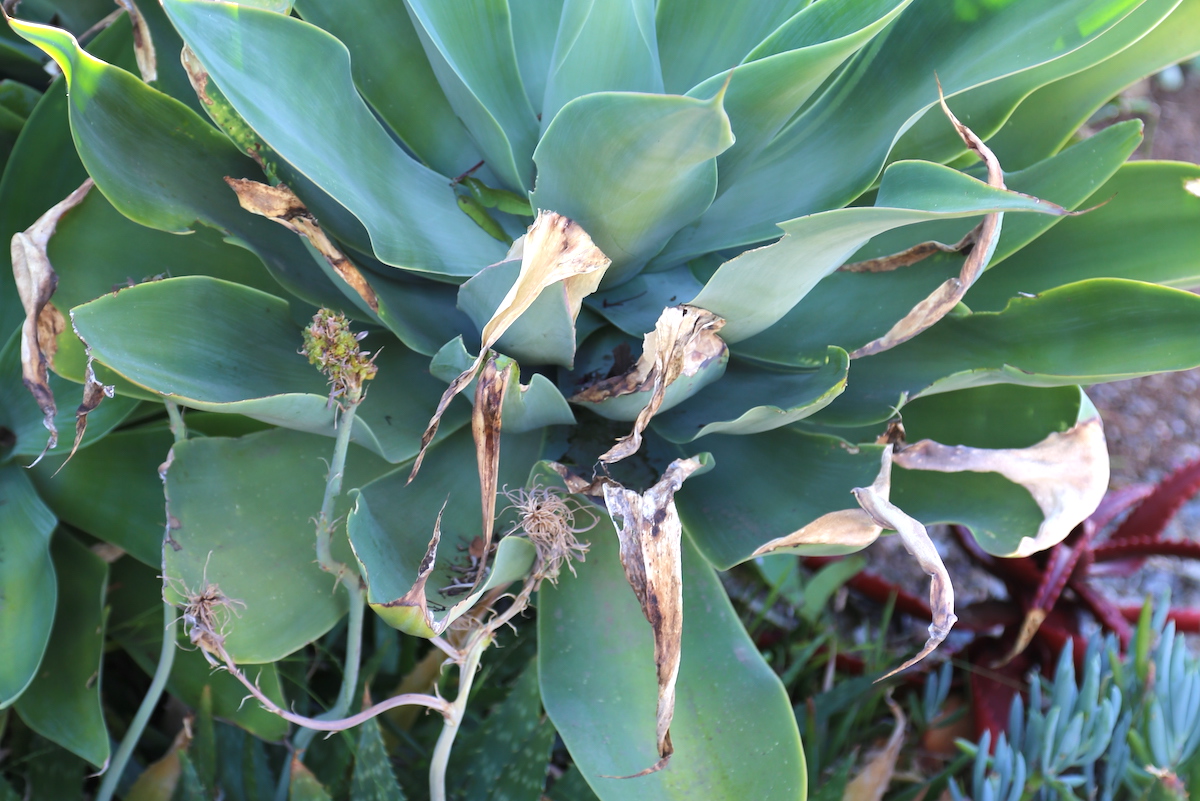
If left unpruned, the damage will continue to look bad months later, even though the plant is fine.
After the Big Texas Freeze
Gwen Pickering in Frisco Texas writes: I can't find a firm answer on whether or not to cut the leaves/tips of my two Blue Agave succulents which have been damaged by the deep freeze we had in Texas this past March. They look like they are thriving but some of the lower leaves are black. I am reading both "yes cut" and "no don't cut" the leaves when I research for an answer. Please advise if you can. Thank you in advance.
Gwen's agaves recovered!
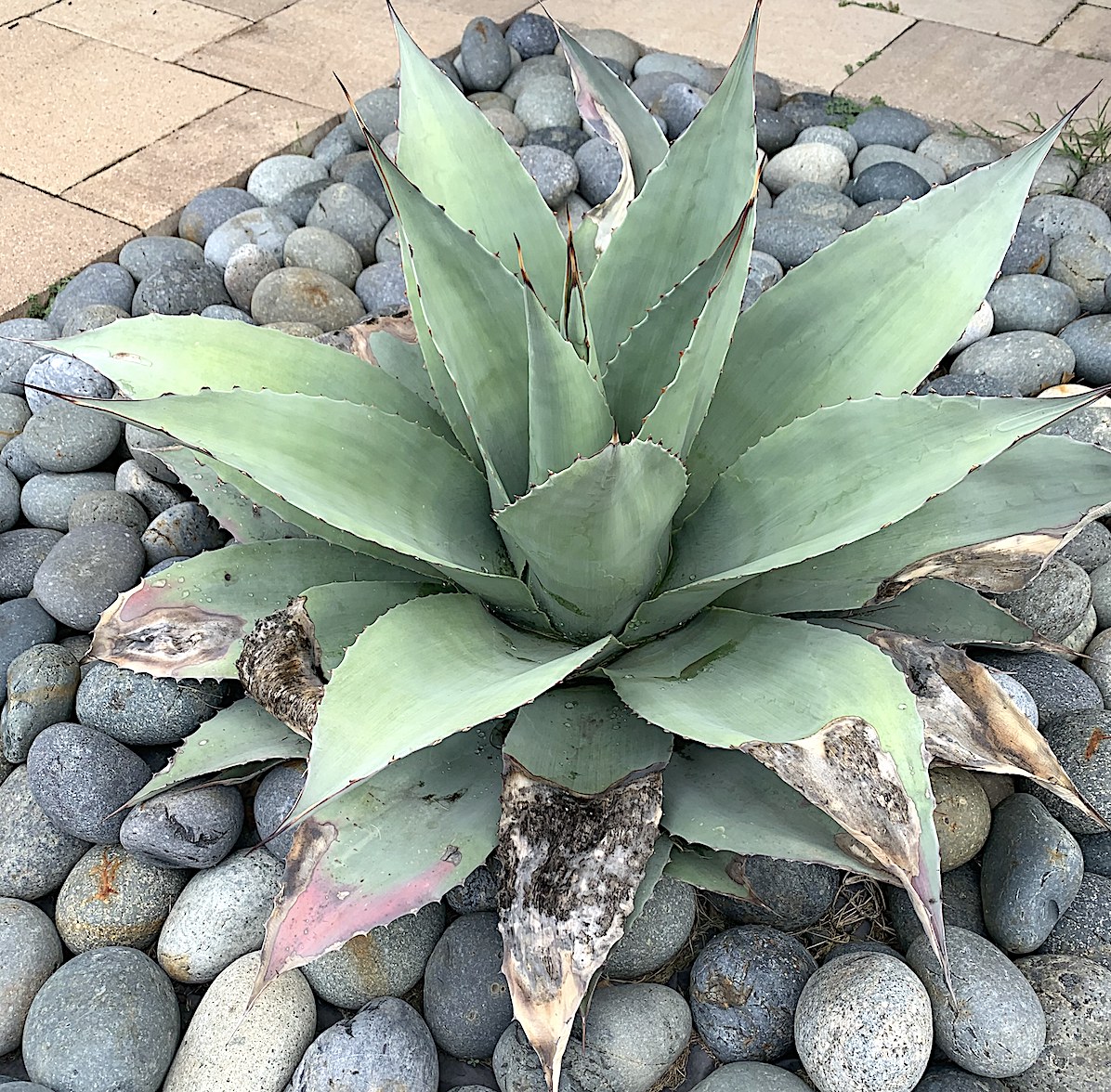
One of Gwen's agaves (Photo: Gwen Pickering)
What you’re seeing on the lower leaves is all that’s left of the damage. New growth is concealing the old. Basically, all Gwen needs to do is to cut the damaged leaves to a point to make the ugly tips go away.
What was the big Texas freeze?
Per Wikipedia: "In February 2021, the state of Texas suffered a major power crisis, which came about as a result of three severe winter storms sweeping across the USA on February 10–11, 13–17, and 15–20; a massive electricity generation failure in the state of Texas; and resultant shortages of water, food, and heat."
By March, 2021, I'd received several emails from Texans asking what to do to salvage their succulents. My advice:
Even though the top growth is severely damaged, your succulents may survive if their roots are intact. You won’t know for certain for several months. Spring—the main growth season for the majority of succulents—can work wonders. Remove any soggy, collapsed leaves as soon as all danger of frost is past. If you don’t see new growth by May or June, it’s probably time to pull up the plants and start over.
Related articles and info:
Winter Protection for Succulents: Products Soggy soil, dim light, high humidity and freezing temperatures can be death to succulents native to warm, arid climates. These items will help you get your succulents through cold, wet North American winters...[Continue reading]
My books have info on growing succulents in challenging climates and how to protect them from frost and excess rain.
I also recommend this excellent book about succulents that survive freezing temps: Hardy Succulents, by Gwen Kelaidis, illustrated by Saxon Holt.

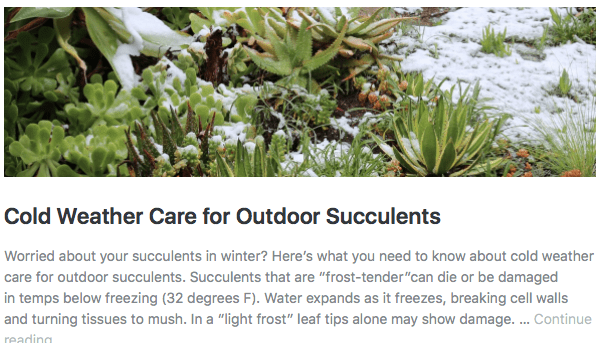
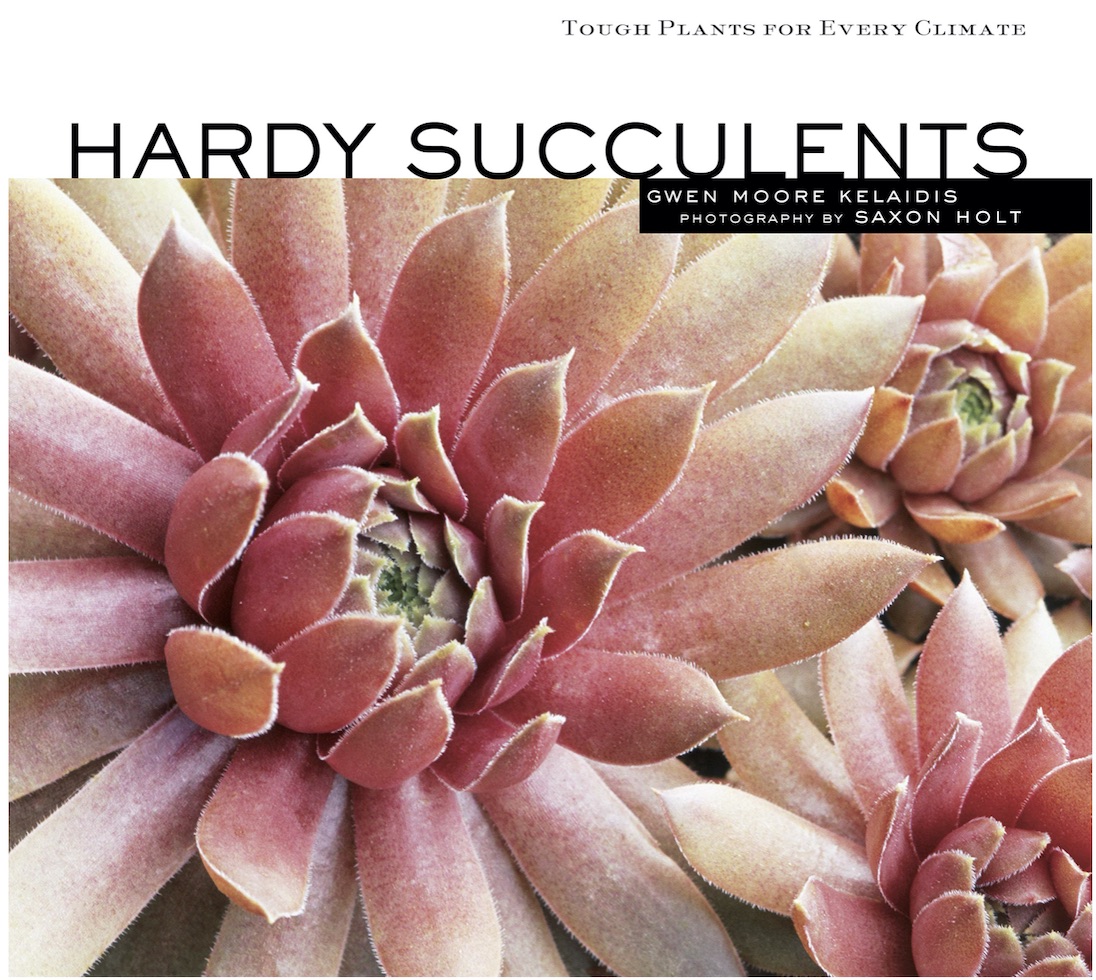
I have a raised bed and put my hanging plants in there covered with frost cloth over wire frame; all inside my new pop-up greenhouse. I put a plant light in there to generate some heat. Today when checking out everything 3 of my kalancho plants have leaves that are an apricot color.. I can’t figure out why some were damaged and others were healthy. The placement of the pots is varied. Did they get too hot or too cold?
Hi Deb — It sounds like there are pockets of cold in your new greenhouse. I’m guessing the leaves turned “apricot” (putty colored) because they froze.
hello,I have watched a lot of your vedios. I have an agave garden in Houston, but with the recent freeze, I covered them but with this unusual freeze and snow , it seems like they are dead and soggy leaves, it makes me very sad to look at them. Can I save them by doing some tricks?. Please advice.
I’ve been watching with dismay the weather reports about Texas over the past few days, but I hadn’t thought about the inevitable damage to the gardens. Sounds like you did the best you could, but no one anticipated the severity of the cold snap. Even though the top growth is severely damaged, your succulents may survive if their roots are intact. You won’t know for certain for several months. Spring—the main growth season for the majority of succulents—can work wonders. Remove any soggy, collapsed leaves as soon as all danger of frost is past. If you don’t see new growth by May or June, it’s probably time to pull up the plants and start over. Keep us posted, OK?
This is very helpful! I live in Austin and even though I took extra steps before the big freeze (with heavier duty coverings) I lost quite a few of my plants *sigh*. Some I’m not sure, it’s hard to tell, but I’ll give this a try and see what happens.
We had a cold snap here in Southern CA in 2007, during which I lost nearly all my crassulas (jades) and kalanchoes. The amount of dead plant material I removed from my garden was disheartening. But it helped me understand my plants and microclimates, and in the long run made the garden better from the standpoint of ease of care and suitable plants. But we only got down to the teens. I hope this was indeed a once-in-a-lifetime event for you and others in Austin. I wonder how members of your local Cactus & Succulent Society managed. I saw some wonderful collections when I was there.
Hi Debra-I was researching how to revive a few succulents and cactus after the freeze and your site came up! I live in Santa Teresa NM next to El Paso and have no experience with the plants here but will hold out hope that they’re not lost. Hello from a classmate from the past!
Hi Shelley! Wow, that was a loooong time ago, but I can see you in my mind exactly as you looked at 16! I hope you find helpful info here and your plants bounce back. Be sure to read the comments, too, especially my reply to “sabu jose.” Thanks for the quick trip down Memory Lane!
My crown of thrones in garage but still look terrible. Any thoughts on those? They are a sone 10 and I’ve successfully overwintered every year. Can’t really stretch bark and all leaves above soil. Any chances of survival?
Hi Monique — Not exactly sure what you’re saying, but the gist seems to be that you’re concerned about your Euphorbia milii. These are highly sensitive to temperature extremes, yet need plenty of light. Not easy except outdoors along the coast of Southern CA. Sounds like you deserve congratulations for keeping them going this long. I’d say if they’re ailing, replace them. They may have rot or pests that might spread to other plants. Hope this helps.
Help please. We had 8 days of ice snow ice again temps in the single digits. Central Texas! My beautiful succulent make my heart ache. Anything I can do?
Hi Juli — I revised this post to add info at the top specifically for Texans, because I’m hearing from many like you who lost beautiful succulent collections. To be honest, with temps that low for that long, recovery is unlikely. I hope that this was unprecedented, and when you start afresh, you needn’t worry it’ll happen again. I wish I could be more positive about the plants you lost. You’ve got a lot of clean-up and removal to do. Truly heartbreaking.
Hello Debra
I have a big cactus in pot
My husband passed 3years ago It was his plant.
I tryed to cover during the long freezing temps ,but didnt work.
Its wilted it was 4 ft tall, now 2ft because lited to the grownd
some green, yellow, little black
Please what should i do
Now to save as much as I can?
Thank you
for any helpful advise you could give me
Sherry
Hi Sherry — With a sharp tool (knife or scissors) cut the damaged tissue so only healthy tissue remains. Each time you cut into diseased tissue, clean the knife by dipping it into Isopropyl alcohol to disinfect it. You don’t want pathogens on the blade when you’re doing surgery. You can use healthy pieces of cactus as cuttings to start new plants. Let them callous (heal) so they’re not raw and juicy, then set them upright in coarse potting soil. Keep them in bright shade and don’t water right away. In a few weeks, gently tug on them, and if they’ve rooted, go ahead and water them as you would normally and move them into greater light (add an hour of morning or afternoon sun a day until they’re in full sun most of the day). What’s left of the original plant will likely regrow, providing the roots are OK. You may end up with many more plants than you started with!
Hey Debra, I live in Austin, TX. I have a covered patio set up where I hang curtains and use an infrared heater to keep my 100+ plants above freezing when it gets below freezing out. Works great. During the big freeze last year I did layers of quilts for extra insulation and it worked great.
Anyways, I have to leave town next week for a funeral and forecast says we will have one night get down to 28 when I am gone, just that one night. Do you think succulents could handle just a couple of hours at that point without closing the curtains?
Each year I wait colder and colder before I do my thing, it seems at around 32, they hold up fine for a few hours, as long as I winterize them by cutting back watering.
Hi Amber — It sounds like you know how to keep your plants safe, by ensuring that temperatures in your covered patio stay above 32 degrees F. Are you asking if you should close the curtains to keep them warmer than if the curtains were open? Yes, but do keep a light on, ideally on a timer so it shuts off at night. Will succulents handle “just a couple of hours” at 28 degrees? It depends on the succulents—some are fine all the way below zero and then some. But for those that are frost-tender, 28 is four degrees below freezing. I wouldn’t risk it. It’s a shame to go to great lengths to keep plants alive, only to lose them in one night.
Hi Debra Iam 86 now in residential care I brought my attenuate with me the frost here can turn them into seaweed jelly!! Should I try and bring it inside where there is a heater going or would that be worse for it. It is part of home I have brought with me I would hate to loose it cheers Patti Straw
Hi Patti, Agave attenuata can show frost damage when exposed to temps in the mid-30s F, which can spoil the look of the plant. Depending on where you have it outdoors, it may not get that cold. Patios are generally warmer than exposed areas. But yes, bring it indoors if you can.
Hi Debra,Hope all is well with you. As you know it’s been a super wet and cold winter here in SW Riverside County as well as North County of SD where you are. I was looking at the damage on my suculents and wondered if I should have water them at all the past 4 months but the ground was so wet I chose not to water at all til now. After reading your articles it became clear that it was the cold and not too much rain which caused them to look so bad. After seeing the pics you posted its definitely frost damage. It’s remarkable the difference between the same plant next to the house verses in the front yard where it is directly exposed to the elements. The pedalanthous next to the house did well except for turning light yellow instead of green but the ones in the front yard have lots of dried up and spotted blackened stalks that must be cut very close to the ground. I didn’t even realize til now how bad it looks and wondered if I should have fertilized it or done anything to help it survive this extremely cold winter more then it did because to be honest I didn’t cover it. I thought covering a 7 foot plant that is 5 feet wide would be too difficult for me and assumed I had to take the covering over and on quite often so I just didn’t do it. This plant in general is super hardy and seems to never stop growing but I wanted to know to be sure if I should wait til the ground dries up,as I normally would,before irrigation is applied or if the plant would have responded better to water out of a drip system then the water from the sky? Essentially should I have kept watering thru the wet winter for some reason that would have benefitted the plants? Should I have fertilized? Was keeping it warm with a cloth the only way to keep that plant healthy? It’s strange cuz I have a lot of other plants and this is the only plant that had so much damage. Any particular fertilizer or water schedule you might suggest at this point with days in the 70s but nights still in the 40s? Thanks as usual. By the way I love all your clever analogies.
Hi Debbie — Fertilizer before or during a winter storm is a good idea because spring brings new growth and rain will dissolve and distribute the nutrients to the roots. No, don’t water during a wet winter. Re covering the plants to prevent frost damage, you do gain a few degrees and prevent frost crystals from landing on leaves. I’m still observing the aftereffects of all the rain…mainly fungus that took out some mangaves and sansevierias. Didn’t see that coming. The snake plants rotted at the core, but the mangaves mostly had leaf damage. I think they’ll recover. A garden is an ongoing learning process!